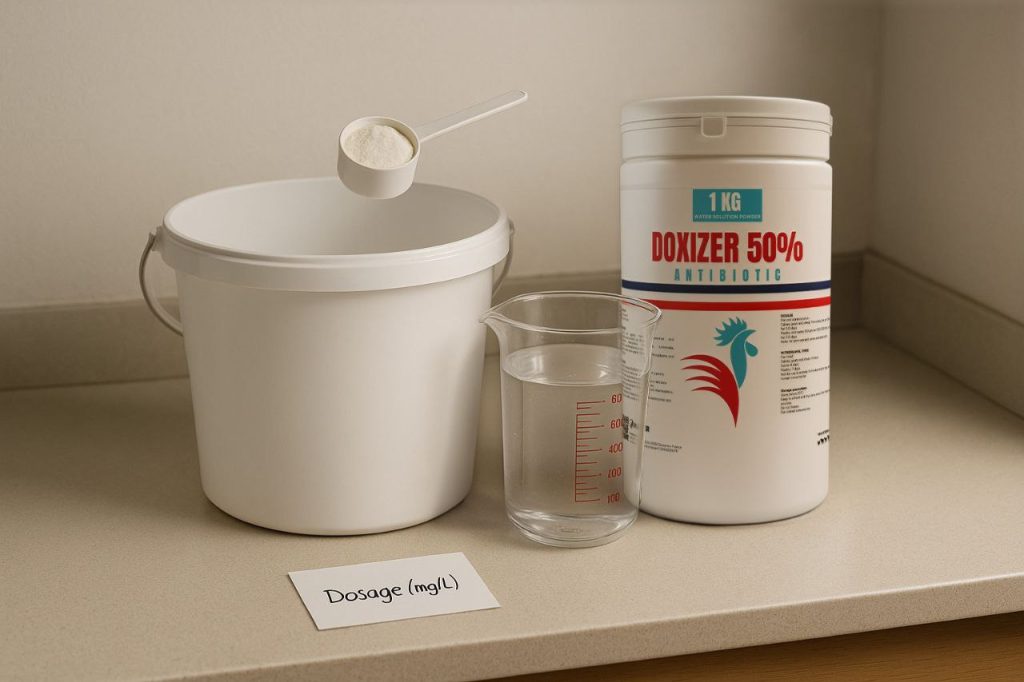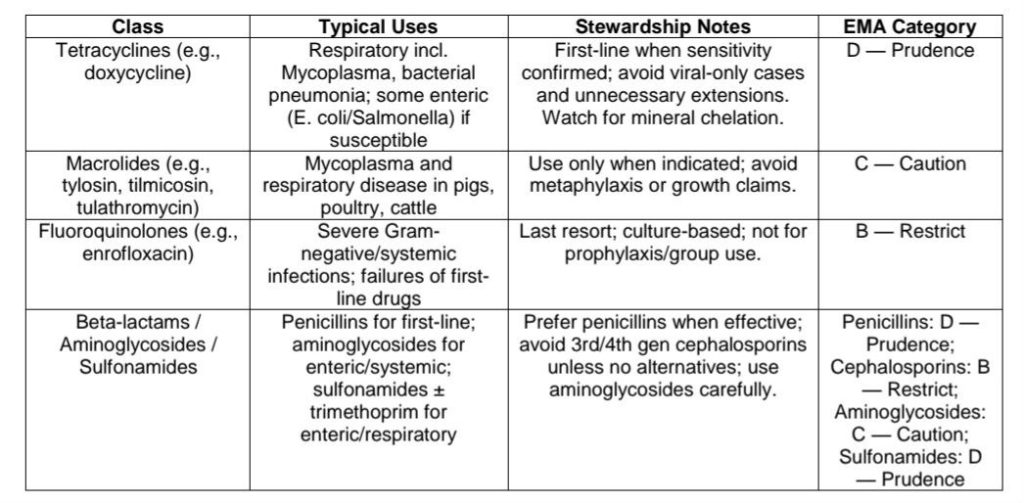
Antibiotics are needed to ensure animal welfare and farm performance, but their use will only tackle or exacerbate issues of resistance in the future. Countries showing declining use are succeeding—with a 13% reduction of antimicrobial use in animals over a 3-year span (2016–2019), highlighting the One Health connection between human, animal, and environmental health. This article presents a species-agnostic framework built on two guiding steps: start smart (early, selective treatment when bacterial infection is probable) and finish right (complete the course and respect withdrawal times). A practical doxycycline example is included.
Using antibiotics against viral infections, ending treatment prematurely, or neglecting withdrawal times are all examples of misuse. Such practices waste resources, harm public health, and accelerate resistance. Stewardship ensures responsible use through correct diagnosis, appropriate drug selection, proper dosage, completion of treatment, and prevention measures to reduce antibiotic demand.
Respiratory complexes, enteric disease, and secondary bacterial infections remain significant threats to animal welfare and productivity. Responsible and precise antibiotic use is essential to safeguard treatment efficacy, protect food supplies, and support sustainable farming.

EU surveillance reports (EFSA/ECDC, 2021–2023) note that tetracycline resistance in poultry- and pig-derived Salmonella is present in 30–40% of isolates. Fluoroquinolone (ciprofloxacin) resistance exceeds 50% in most Member States. Macrolide resistance is lower, though elevated in Campylobacter jejuni. Resistance declined in countries reducing veterinary antimicrobial use; global AMU fell 13% between 2016–2019. Practical advice: use first-line “prudence” drugs (e.g., tetracyclines when sensitivity is confirmed) and reserve “restrict” drugs (e.g., fluoroquinolones) for culture-supported cases only.
- Always start with diagnosis (culture/PCR if available).
- Ensure veterinary oversight for every treatment course.
- Apply correct dose, route, and duration (avoid underdosing and unjustified extensions).
- Enforce strict withdrawal times.
- Prioritize prevention (vaccination, hygiene, ventilation, biosecurity).
1. Begin Right (Concentrated Preliminary Application)
Mini decision guide
- Bacterial/mycoplasmal likely if: clustered fever in a group, colored/purulent nasal discharge or coughing with exudate, evenly raised respiration rate or breathlessness, farm history of Mycoplasma, Pasteurella, E. coli, or prior effective antibiotic response.
- Viral-only more likely if: clear discharge, short self-limiting fever (<24–48 h), scattered cases, minimal purulence, appetite retained, and seasonal viral exposure without bacterial signs.
24–48 h reassessment: check temperature trend, feed/water intake, respiration effort, new-case curve, and confirm accurate dosing. Treat bacterial/mycoplasmal cases; avoid treating viral-only disease. Prefer the narrowest effective antibiotic based on history and lab results.

2. End Strong (Complete Full Term + Withdrawal)
Stopping too early leaves surviving bacteria; overdosing promotes resistance. Finish treatment exactly as prescribed, respect withdrawal periods, and follow recovery measures (improved ventilation, hydration, stress reduction)—not more antibiotics.
- Dosage: 100 g/500–1,000 L drinking water for 3–5 days.
- Withdrawals: Poultry 7 days • Swine 8 days • Calves/small ruminants 14 days.
- Restrictions: Not for layers producing eggs for human consumption or lactating animals; use only in pre-ruminant calves/lambs if justified.
- Stewardship Positioning: EMA AMEG Category D — “Prudence,” meaning suitable as a first-line therapy when effective, preserving higher-priority human drugs.
Mixture example (mg/L target): Using DOXIZER 50% (500 mg/g doxycycline): 100 g in 1,000 L = 50 mg/L doxycycline; 100 g in 500 L = 100 mg/L doxycycline. Choose within label range depending on disease severity and water intake.

- Do: Prepare fresh solution daily, keep medicator and lines clean, record treatment details (batch, dose, group, withdrawal dates).
- Don’t: Combine with Ca/Mg/Fe supplements that reduce efficacy; don’t extend treatment beyond label.

Estimate water consumption, adjust dosing to achieve target mg/L, refresh solutions daily, remove conflicting additives, confirm waterline flow, and medicate when animals are likely to drink.
Keep treatment logs (group, drug/lot, dose, start/stop, withdrawal). Conduct internal monitoring and keep forms for regulators/buyers. If no improvement in 48 h, escalate diagnostics and reconsider drug choice or route under veterinary supervision.

- Poultry house: Veterinary-guided early treatment reduced cough scores within 48 h and restored egg production by day 5 — an example of Start Smart.
- Calf pen: Correct dosing for 3–5 days with strict withdrawals and recovery measures reduced relapse pneumonia by ~40% and improved daily gain — proof of Finish Right.

- Respiratory signs just started — what should I do first? Begin with pattern recognition (fever clusters, purulent discharge, increased respiration) and act within the early treatment window. See: Two critical moments that safeguard livestock respiratory health.
- How can I cut antibiotic use through prevention? Strengthen the gut and the barn: beneficial microbes, smart ventilation, dry/clean floors. See: Three‑way shield against enteritis.
- We’re dealing with diarrhea — what’s the immediate plan? Rehydration first, diagnostics second, targeted meds last. See the step‑by‑step: Understanding and managing diarrhea in large animals.
- Is coccidiosis part of this picture — and which drugs are appropriate? When Eimeria is confirmed/likely, choose ionophores or synthetics appropriately, mind rotation and withdrawals. See: What are anticoccidial drugs?.
- What if there’s no improvement by 24–48 h? Verify dosing and water intake, escalate diagnostics, and reassess pathogens and route. Revisit the early‑action checklist in Respiratory: two critical moments and the triage/rehydration flow in Diarrhea in large animals.
- Why are withdrawals non‑negotiable? They protect consumers, market access, and legal compliance; complete the course and respect labeled withdrawal times.
- Begin → Signs/history suggest bacteria → start under vet supervision + sample if possible.
- Treat → Choose correct class, dose, route, short labeled course (3–5 days).
- Complete → Stop on time, respect withdrawals, focus on recovery supports.
- Prevent → Vaccinate, ventilate, maintain hygiene, and document.
Antibiotics save herds when used only when necessary and correctly. Start smart, finish right. Doxycycline-class antibiotics are prudent first-line options when sensitivity supports it. Preserve critical human drugs for last-resort, culture-backed cases. Prevention reduces antibiotic demand and resistance pressure.
Always consult your veterinarian for diagnosis and prescription. Local regulations and label instructions govern withdrawal times and legal use.

